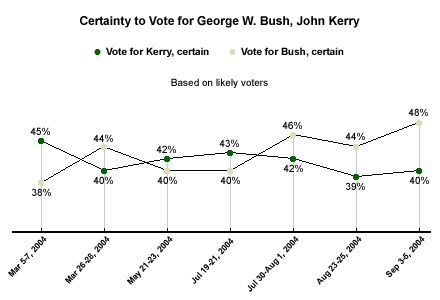


"Swing Voters" in the 2004 Presidential Election
Tuesday, September 7, 2004
by Joseph Carroll
Throughout the campaign this year, in addition to asking whom they plan to vote for, Gallup has asked Americans whether they are certain they will vote for their candidate or they could change their minds before Election Day. The latest CNN/USA Today/Gallup poll, conducted this past weekend after the Republican National Convention in New York, finds President George W. Bush leading Democratic challenger John Kerry, by 52% to 45% among likely voters. The latest poll shows that 88% of Americans deemed most likely to vote in this year's election are firm in their vote choices, and only 12% of likely voters say they may change their minds.
Strength of Support for Bush, Kerry
The current poll finds that 48% of likely voters say they are certain that they will vote for Bush in November, while 40% are certain to vote for Kerry. These results show the highest percentage of likely voters saying they are certain to vote for Bush since March. In early March, 38% said they were certain to vote for Bush. This increased to 44% by the end of March, and then declined slightly to 40% in May and mid-July. After the Democratic convention, 46% of likely voters said they were certain to vote for Bush. Two weeks ago, 44% said they were certain to vote for Bush.
At the same time, the percentage of likely voters who are certain to vote for Kerry has remained more consistent, ranging from 39% to 45% from March through the latest poll. Over the past three polls, roughly 4 in 10 likely voters say they are certain to vote for Kerry.
Trends on "Swing Voters"
Gallup has found low numbers of swing voters during this year's campaign. In March, 17% of likely voters said they might change their minds about whom to vote for in the November election. These results remained essentially unchanged until Gallup's post-Democratic convention poll in late July/early August, when that percentage dipped to 12%. A subsequent poll in mid-August found a slight increase to 17% of likely voters, before falling once again to 12% after the GOP convention.
Who Are the "Swing Voters?"
To more closely examine "swing voters," Gallup combined the results of its past four surveys, from mid-July through early September. The results, based on likely voters, show that certain groups are more inclined to be "swing voters" than are others. But bear in mind that in most subgroups, the vast majority of people have already decided whom they are going to vote for.
- Independents are much more likely to be swing voters than are Republicans or Democrats. One in four independents say they may change their minds, compared with 11% of Republicans and Democrats.
- Twenty percent of moderates say they could change their minds, while only 11% of liberals and conservatives share that view.
- Twenty-two percent of Republicans who have a moderate or liberal ideology are swing voters. This compares with only 8% of conservative Republicans.
- Women are slightly more likely than men to be swing voters, by 16% to 13%.
- Older Americans, those aged 65 and older, are less likely to be swing voters than are 18- to 29-year-olds.
- Easterners, at 20%, are more likely than voters living elsewhere to be swing voters, compared with 16% of Midwesterners, 12% of Southerners, and 12% of Westerners.
- There are roughly equal proportions of swing voters in safe Republican states, safe Democratic states, and so-called showdown states.
- Voters with less education, particularly those without a high school diploma, are more inclined to change their minds before Election Day.